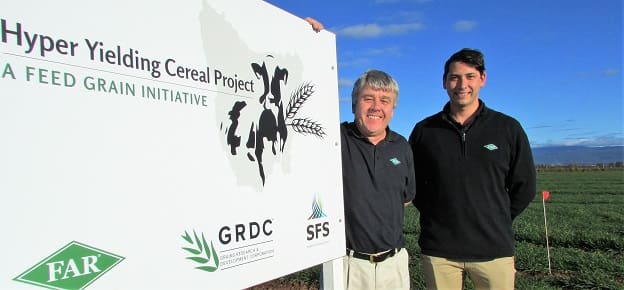
FAR Australia’s Nick Poole and Darcy Warren at the GRDC Hyper Yielding Cereals Project field research site at Hagley in Tasmania. (Photo: GRDC)
A FIVE-YEAR project to close the cereal crop yield gap in Tasmania has passed the half-way mark and is producing results that are set to rewrite the state’s cereal production targets.
A collaboration of international, national and local expertise and breeders, the Hyper Yielding Cereals Project is working to close the yield gap between actual and potential yields as well as using links with end users to promote the value of trading quality feed grains.
The project aims to boost Tasmania’s production of high quality feed grain cereals and thereby reduce its reliance on supplies from the mainland.
Despite a more suitable climate for grain production than the mainland and a much higher yield potential, the average yield of red grain feed wheat in Tasmania is still around five tonnes/hectare – considered to be well below the potential.
A GRDC investment, the project is being led by FAR (Foundation for Arable Research) Australia in collaboration with Southern Farming Systems (SFS).
FAR Australia’s managing director Nick Poole said the project was working towards setting record yield targets as aspirational goals for growers of feed grains.
“The project has been set the challenge of increasing average Tasmanian red grain feed wheat yields from 4.4 tonnes/hectare to 7t/ha by 2020, and delivering commercial wheat crops which yield up to 14t/ha by 2020,” Mr Poole said.
In the project’s first year in 2016 (an exceptional year in terms of growing season rainfall and conditions), the results exceeded the project’s yield targets; late April-sown wheat yielded more than 16t/ha in experimental plots, and barley sown at the same time yielded in excess of 10t/ha.
The soft finish and high rainfall experienced during 2016 was in stark contrast to 2017 when low rainfall, higher temperatures and late frosts affected the grain fill period at the research site.
Despite the less favourable conditions, wheat yields peaked at 12.5t/ha to 13t/ha from both early and late April sown crops.
Interestingly, barley yields were higher than 2016 and peaked at 11t/ha to 11.5t/ha, up 1t/ha on the previous year.
Mr Poole said the contrast between the 2016 and 2017 seasons had been useful in determining which new cultivars and lines had potential across very different seasons.
“It has provided more opportunity to address which germplasm has the correct phenology (developmental ‘time clock’) for the early and more normal Anzac Day sowing window,” he said.
“In 2016, high disease pressure, which was the result of much higher autumn temperatures and wetter spring conditions, reduced the yields of most wheat cultivars sown in early April relative to the more typical late April sown dates.
“In 2017, the advantages of early April sowing were observed in a wider range of wheat germplasm as later sowings were exposed to more heat stress during grain fill and early sowings suffered less disease pressure.”
Source: GRDC
Key findings from the research to date will be presented to growers, advisers and industry personnel at a field day on Badcock Lane at Hagley in northern Tasmania on November 15.
Details: http://bit.ly/2qcHU16
More information: Event co-ordinator Rachel Lowther, 0420 503603, [email protected]
Grain Central: Get our free daily cropping news straight to your inbox – Click here



HAVE YOUR SAY